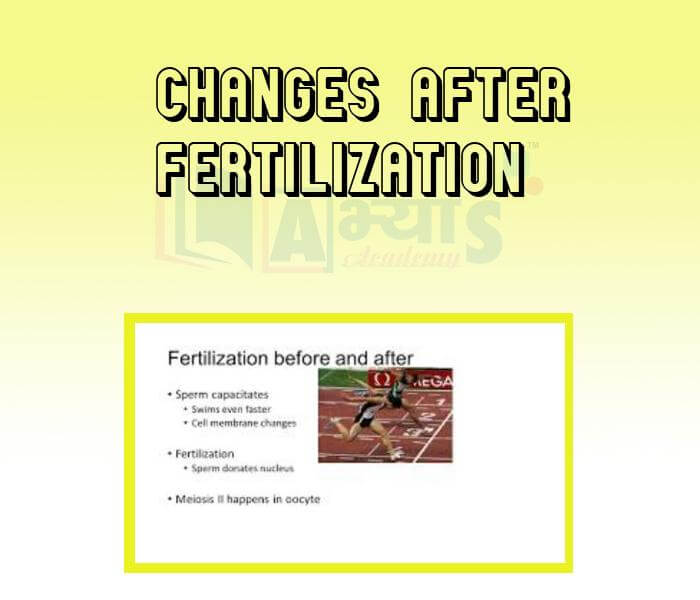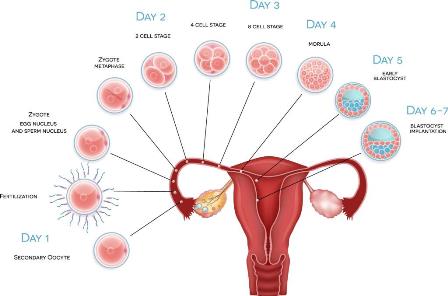Changes After Fertilization










Changes After Fertilization
Implantation: The fertilized egg (zygote) moves down the Fallopian tube and continuously undergoes cell division and forms 2, 6, 8 , 16 cells and so on. By the time it reaches the uterus it has already formed a small hollow ball of numerous cells (blastocyst). This is a kind of embryo which forms a pit in the wall of the uterus and gets fixed in it in about a week's time after ovulation. This is a kind The embryo gets embedded in the wall of the uterus, which is thick and has muscles, glands and a large number of blood capillaries. This process is called implantation.
Pregnancy: The developing embryo at first derives nourishment directly from the mother’s blood flowing in the vessels lining the uterine wall. In about three weeks, it starts absorbing food and oxygen through an organ called placenta. The placenta is a disc like organ in the lining of the uterine wall. It has numerous villi, which are in direct contact with the mother’s blood flowing in the uterine wall. These villi provide a large surface area for glucose and oxygen to pass from the mother to the embryo and for wastes produced by the embryo to be passed into the mother’s blood. The embryo is connected to the placenta by a tube called the umbilical cord. By the end of five weeks of pregnancy, the embryo is quite advanced. The heart and circulatory system have been formed. After two months limbs have also been formed. By eight weeks, the embryo starts showing human features and is referred to as foetus. The total period of embryonic development, from the time of fertilization to birth, is called gestation period. It is around 280 days, or 9 months, in humans.
Birth: The wall of the uterus develops a thick layer of muscles during pregnancy. At the time of birth, the uterine muscles contract rhythmically and powerfully, causing labour pains to the mother. At the time of birth, the baby is pushed out by powerful contractions.Finally, the baby is expelled by the contraction of the uterine muscles. This is called birth or parturition.
What happens when the egg is not fertilized: If the ovum is not fertilized in the upper part of the oviduct, it keeps on descending and is finally passed out through the vagina. It remains in the body for about 24 - 72 hours. As an egg is released for fertilization every month, the uterus also prepares itself every month for the implantation of a fertilized egg. The uterus becomes thick-walled and spongy in order to nourish the embryo. If no fertilization takes place, the thick uterine wall is no longer needed. So, it gradually begins to shrink. This shrinkage ruptures its blood vessels. As a result, blood and mucus ooze out of the vagina. This period, which lasts for 3—5 days, is called the menstrual period, and the process is called menstruation. If the ovum is fertilized, it gets implanted in the uterus wall and embryonic development starts. In this case, the uterus continues to develop in order to hold the embryo. And in this case, there is no question of its shrinkage resulting in menstruation.

Number of cells present in egg is __________________ | |||
| Right Option : A | |||
| View Explanation | |||
Settling down of blastocyst on uterine wall is called ______________________ | |||
| Right Option : A | |||
| View Explanation | |||
Connection between developing embryo and placenta is called ______________________ | |||
| Right Option : A | |||
| View Explanation | |||
Students / Parents Reviews [20]
Abhyas is an institute of high repute. Yogansh has taken admission last year. It creates abilities in child to prepare for competitive exams. Students are motivated by living prizes on basis of performance in Abhyas exams. He is satisfied with institute.

Yogansh Nyasi
7thAbhyas is a complete education Institute. Here extreme care is taken by teacher with the help of regular exam. Extra classes also conducted by the institute, if the student is weak.

Om Umang
10thAbhyas Methodology is very good. It is based on according to student and each child manages accordingly to its properly. Methodology has improved the abilities of students to shine them in future.

Manish Kumar
10thAbout Abhyas metholodology the teachers are very nice and hardworking toward students.The Centre Head Mrs Anu Sethi is also a brilliant teacher.Abhyas has taught me how to overcome problems and has always taken my doubts and suppoeted me.

Shreya Shrivastava
8thMy experience with Abhyas is very good. I have learnt many things here like vedic maths and reasoning also. Teachers here first take our doubts and then there are assignments to verify our weak points.

Shivam Rana
7thUsually we see institutes offering objective based learning which usually causes a lag behind in subjective examinations which is the pattern followed by schools. I think it is really a work of planning to make us students grab the advantages of modes of examination, Objective Subjective and Onli...

Anika Saxena
8thMy experience with Abhyas academy is very nice or it can be said wonderful. I have been studying here from seven class. I have been completing my journey of three years. I am tinking that I should join Abhyas Academy in tenth class as I am seeing much improvement in Maths and English

Hridey Preet
9thIt was a good experience with Abhyas Academy. I even faced problems in starting but slowly and steadily overcomed. Especially reasoning classes helped me a lot.

Cheshta
10thIt was good as the experience because as we had come here we had been improved in a such envirnment created here.Extra is taught which is beneficial for future.

Eshan Arora
8thIn terms of methodology I want to say that institute provides expert guidence and results oriented monitering supplements by requsite study material along with regular tests which help the students to improve their education skills.The techniques of providing education helps the students to asses...

Aman Kumar Shrivastava
10thAbhyas is good institution and a innovative institute also. It is a good platform of beginners.Due to Abhyas,he has got knoweledge about reasoning and confidence.My son has improved his vocabulary because of Abhyas.Teacher have very friendly atmosphere also.

Manish Kumar
10thMy experience with Abhyas Academy has been very good. When I was not in Abhyas whenever teacher ask questions I could not speak it confidently but when I came in Abhyas, my speaking skills developed and now I am the first one to give the answer of teachers question.

Upmanyu Sharma
7thAbhyas institute is one of the best coaching institute in the vicinity of Ambala Cantt area. The teachers of the institute are well experienced and very helpful in solving the problems of the students.The good thing of the institute is that it is providing extra classes for the students who are w...

Aman Kumar Shrivastava
10thMy experience was very good with Abhyas academy. I am studying here from 6th class and I am satisfied by its results in my life. I improved a lot here ahead of school syllabus.

Ayan Ghosh
8thIt has a great methodology. Students here can get analysis to their test quickly.We can learn easily through PPTs and the testing methods are good. We know that where we have to practice

Barkha Arora
10thI have spent a wonderful time in Abhyas academy. It has made my reasoning more apt, English more stronger and Maths an interesting subject for me. It has given me a habbit of self studying

Yatharthi Sharma
10thA marvelous experience with Abhyas. I am glad to share that my ward has achieved more than enough at the Ambala ABHYAS centre. Years have passed on and more and more he has gained. May the centre flourish and develop day by day by the grace of God.

Archit Segal
7thMy experience with Abhyas academy is very good. I did not think that my every subject coming here will be so strong. The main thing is that the online tests had made me learn here more things.

Hiya Gupta
8thWhen I have not joined Abhyas Academy, my skills of solving maths problems were not clear. But, after joining it, my skills have been developed and my concepts of science and SST are very well. I also came to know about other subjects such as vedic maths and reasoning.

Sharandeep Singh
7thWe started with lot of hope that Abhyas will help in better understnding of complex topics of highers classes. we are not disappointed with the progress our child has made after attending Abhyas. Though need to mention that we expected a lot more. On a scale of 1-10, we would give may be 7.
